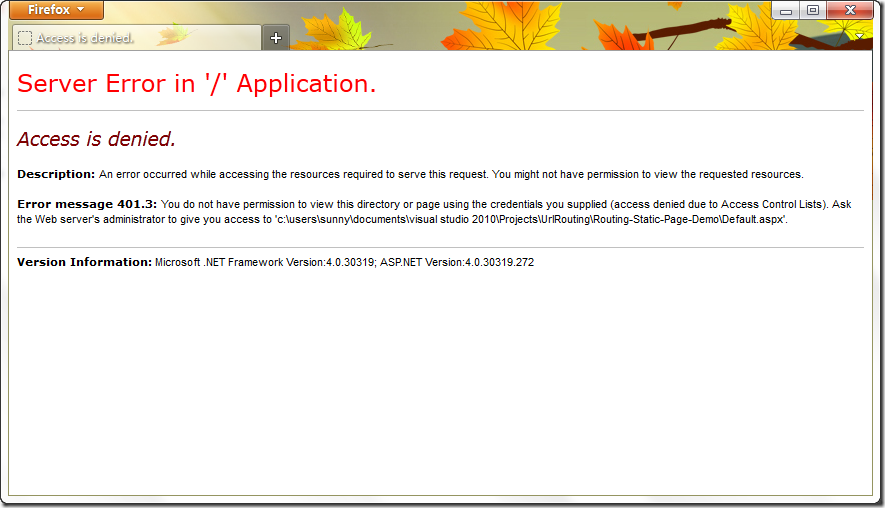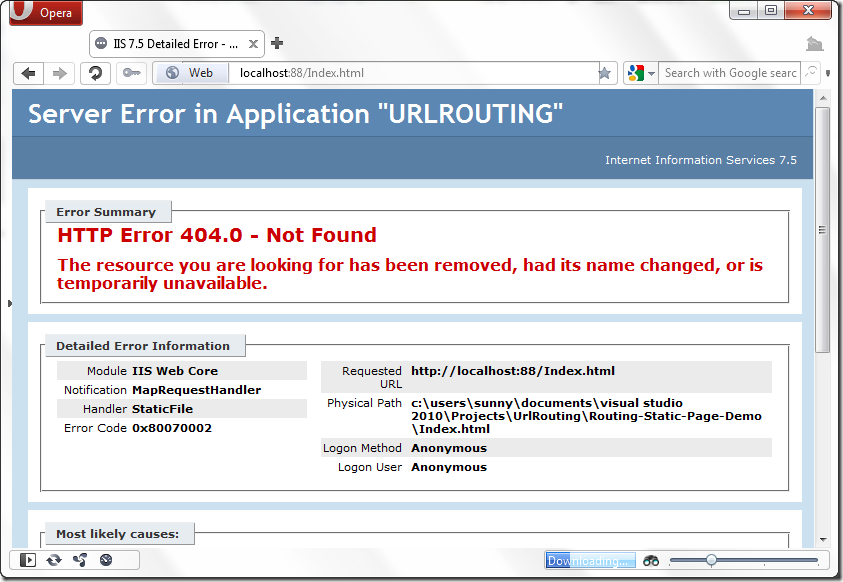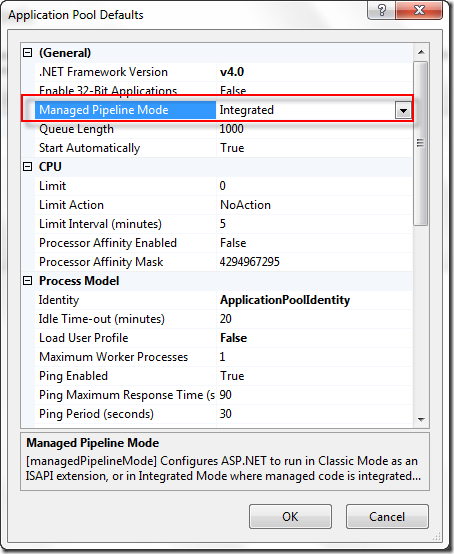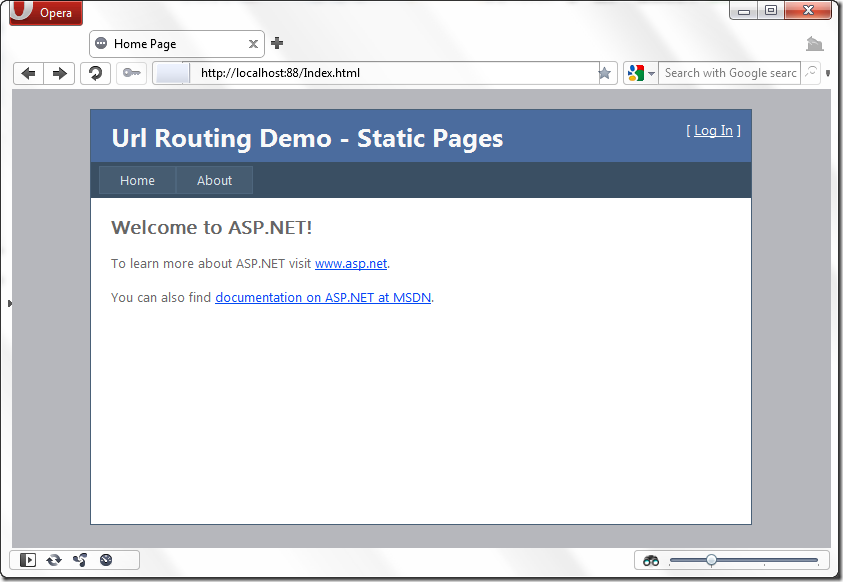[转载]ASP.NET 路由实现页面静态化(附在线Demo和Source) – keepfool – 博客园.
页面静态化最大的好处是利于SEO,即使是伪静态,搜索引擎也会觉得这是一个较为友好的 Url。Url的友好也取决于其命名,为一篇描述古代文学的页面起名用ancient-literature.html当然比随便起的名字例如 aa.html之流要友好。页面静态化并不代表你一定要用后缀名为.html或.htm的链接来显示你的页面,你完全可以不用任何后缀名(就像MVC一 样),只要Url结构良好。
实现静态化的三个目标:
1. 实现页面静态化,页面中的链接都用.html来表示,但每个.html实际都映射了一个.aspx页面。
例如:当用户请求index.html页面时,实际请求的是Default.aspx页面,index.html的物理路径在网站中并不存在。
2. 实现请求.aspx页面时自动跳转到对应的静态映射页面。
例如:当用户请求Default.aspx页面,自动跳重定向到index.html页面
3. 自定义404页面的实现,当请求的路径既不在映射表中,也不在网站的虚拟路径中时,它将自动跳转到我预先设定好的404页面。
实现以上要点,需要用到ASP.NET Url Routing、HttpHandler和HttpModule技术。
这是一个小系列的文章,这一篇文章将详细解说并实现第1点。
本文已经同步至我的个人博客站点:积累吧|ASP.NET 路由实现页面静态化
一、项目创建
1. 创建一个ASP.NET Web Application项目
2. 创建web.config文件
ASP.NET Membership在这里使用不到,所以生成的web.config配置没有用处,删掉它并重新创建一个新的web.config文件
<?xml version="1.0"?> <configuration> <system.web> <compilation debug="true" targetFramework="4.0" /> </system.web> </configuration>
3. 将网站添加到IIS6或IIS7中
默认的ASP.NET Web Application已经为我们提供了不少页面,我就在下面的例子中将它们静态化吧。
二、页面静态化实现
1. 添加Routing引用
由于这里需要用到ASP.NET的路由映射(从.NET 3.5开始诞生),所以需要在项目中添加System.Web.Routing引用。
2. 添加WebHandler和WebModule文件夹
这两个文件夹分别用于存放IHttpHandler和IHttpModule。
3. 将所有.aspx后缀的超链接更改为.html
Site.Master文件:
<asp:Menu ID="NavigationMenu" runat="server" CssClass="menu" EnableViewState="false" IncludeStyleBlock="false" Orientation="Horizontal"> <Items> <asp:MenuItem NavigateUrl="~/Index.html" Text="Home"/> <asp:MenuItem NavigateUrl="~/About.html" Text="About"/> </Items> </asp:Menu>
Account文件夹ChangePassword.aspx文件:
<asp:ChangePassword ID="ChangeUserPassword" runat="server" CancelDestinationPageUrl="~/" EnableViewState="false" RenderOuterTable="false" SuccessPageUrl="ChangePasswordSuccess.html">
当然现在这三个静态链接都访问不到,因为它们的物理地址不存在。
下面我们要做的就是:
1) 请求Index.html时实际请求的是Default.aspx
2) 请求About.html时实际请求的是About.aspx
3) 请求Account/Login.html时实际请求的是Account/Login.aspx
4. 添加自定义的IRouteHandler实现
using System.Web; using System.Web.Compilation; using System.Web.Routing; using System.Web.UI; namespace Routing_Static_Page_Demo.WebHandler { public class CustomRouteHandler : IRouteHandler { /// <summary> /// 虚拟路径 /// </summary> public string VirtualPath { get; private set; } public CustomRouteHandler(string virtualPath) { this.VirtualPath = virtualPath; } /// <summary> /// 返回实际请求页 /// </summary> public IHttpHandler GetHttpHandler(RequestContext requestContext) { var page = BuildManager.CreateInstanceFromVirtualPath(VirtualPath, typeof(Page)) as IHttpHandler; return page; } } }
5. 在Global.asax文件中注册路由
先来个简单的实现:
using System; using System.IO; using System.Web.Routing; using Routing_Static_Page_Demo.WebHandler; namespace Routing_Static_Page_Demo { public class Global : System.Web.HttpApplication { void Application_Start(object sender, EventArgs e) { RegisterRoutes(); } /// <summary> /// 注册路由 /// </summary> private void RegisterRoutes() { //将Index.html请求映射为Default.aspx RouteTable.Routes.Add("Default", new Route("Index.html", new CustomRouteHandler("~/Default.aspx"))); // 将About.html请求映射为About.aspx RouteTable.Routes.Add("About", new Route("About.html", new CustomRouteHandler("~/About.aspx"))); // 将Account/Login.html请求映射为/Account/Login.aspx RouteTable.Routes.Add("Login", new Route("Account/Login.html", new CustomRouteHandler("~/Account/Login.aspx"))); } } }
在VS中直接运行站点(VS自带的WebDev服务器),点击这些链接都能够正常访问。
三. 在IIS 7下设置站点
下面的设置很重要,因为上面在VS自带的web服务器中虽然跑通了,但IIS 7下是运行不通过的(IIS 6下的设置很简单,本文的在线Demo是运行在IIS 6下的)
1. 初次在IIS 7下运行该网站,会出现下面的错误。
这是因为IIS对该Web站点目录没有读写权限。
在IIS下:右键站点 > Edit Permissions > Security > Edit > Add > 输入IIS_IUSRS > Check Names > OK。
选择完毕后,为IIS_IUSRS用户添加Full Control权限。
2. 添加完该设置后,再运行一次网站,可能会出现下面的错误。
按照上面的步骤添加IUSR用户,为IUSR用户分配Read权限即可。
再次运行网站,能够正常访问页面了。
3. 配置web.config
网站虽然能运行,但是点击Home或About链接时会出现404错误。
i. 首先确保在安装IIS时你已经勾选了HTTP Reirection
如果没有安装这个功能,按照如下设置再配置一遍IIS
Control Panel –> Progams –> Turn off windows features –> World wide web Services –> Common HTTP Features –> HTTP Redirection
ii. 修改web.config文件,在webserver中注册RoutingHandler和RoutingModule
<?xml version="1.0" encoding="UTF-8"?> <configuration> <system.web> <compilation debug="true" targetFramework="4.0" /> </system.web> <system.webServer> <modules runAllManagedModulesForAllRequests="true"> <remove name="UrlRoutingModule"/> <add name="UrlRoutingModule" type="System.Web.Routing.UrlRoutingModule, System.Web, Version=4.0.0.0, Culture=neutral, PublicKeyToken=b03f5f7f11d50a3a" /> </modules> <handlers> <add name="UrlRoutingHandler" preCondition="integratedMode" verb="*" path="UrlRouting.axd" type="System.Web.HttpForbiddenHandler, System.Web, Version=2.0.0.0, Culture=neutral, PublicKeyToken=b03f5f7f11d50a3a"/> </handlers> </system.webServer> </configuration>
注意: 如果你采用的是ASP.NET 3.5 Routing或使用IIS 6,web.config配置会不一样。
iii. 确保web站点的应用程序池选择的是集成模式,因为ASP.NET 4.0 Routing并不支持经典模式
OK,似乎所有的该配置的地方都配置了,那么再去点击Index.html或About.html链接试试吧。
如果现在去访问Login.html页面,还是会得到一个401.3的错误,更改Account目录下的web.config文件:
<?xml version="1.0"?> <configuration> <location path="Register.aspx"> <system.web> <authorization> <allow users="*"/> </authorization> </system.web> </location> <system.web> <!--<authorization> <deny users="?"/> </authorization>--> </system.web> </configuration>
如果你不需要这个web.config文件,直接删掉也可以。
四. 更改RegisterRoutes方法
上面提供的注册路由的方式属于硬编码,需要为每一个.aspx页面指定映射路由。Account目录下还有一些.aspx文件,如果增加别的目录也存放.aspx页面,为了让每个页面都静态化,RegisterRoutes方法将会是产生很多重复代码。
using System; using System.IO; using System.Web.Routing; using Routing_Static_Page_Demo.WebHandler; namespace Routing_Static_Page_Demo { public class Global : System.Web.HttpApplication { void Application_Start(object sender, EventArgs e) { RegisterRoutes(); } /// <summary> /// 注册路由 /// </summary> private void RegisterRoutes() { //将Index.html请求映射为Default.aspx RouteTable.Routes.Add("Default", new Route("Index.html", new CustomRouteHandler("~/Default.aspx"))); // 将About.html请求映射为About.aspx RouteTable.Routes.Add("About", new Route("About.html", new CustomRouteHandler("~/About.aspx"))); // 遍历页面存放目录,为每个.aspx页面添加路由映射 foreach (string mapPth in _pageMapPath) { string path = Server.MapPath(mapPth); var directoryInfo = new DirectoryInfo(path); foreach (FileInfo f in directoryInfo.GetFiles()) { string fileName = f.Name; if (fileName.EndsWith(".aspx")) { string routeName = fileName.Substring(0, fileName.Length - 5); string url = string.Concat(mapPth.Substring(2), routeName, ".html"); RouteTable.Routes.Add(routeName, new Route(url, new CustomRouteHandler(string.Concat(mapPth, fileName)))); } } } } // 页面存放目录 private readonly string[] _pageMapPath = {@"~/Account/"}; } }
以上代码就能实现为每个.aspx页面注册路由实现静态化。
 Mikel
Mikel
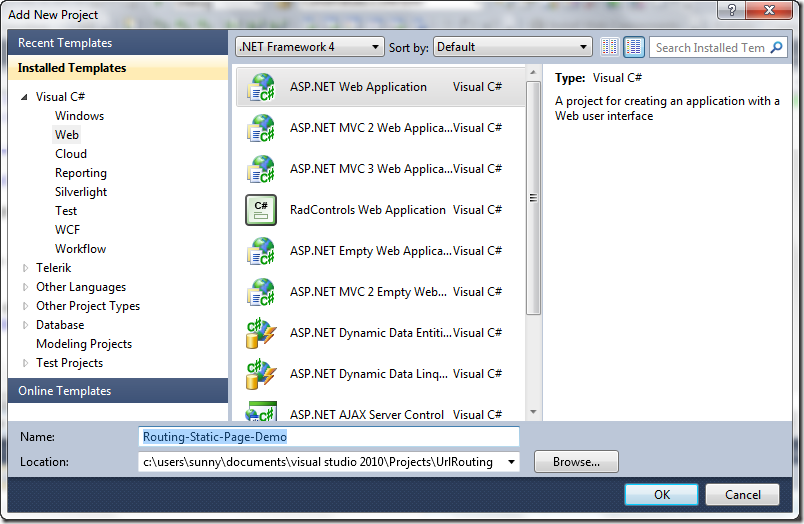
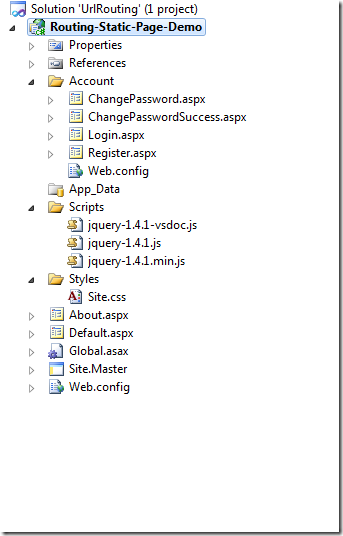

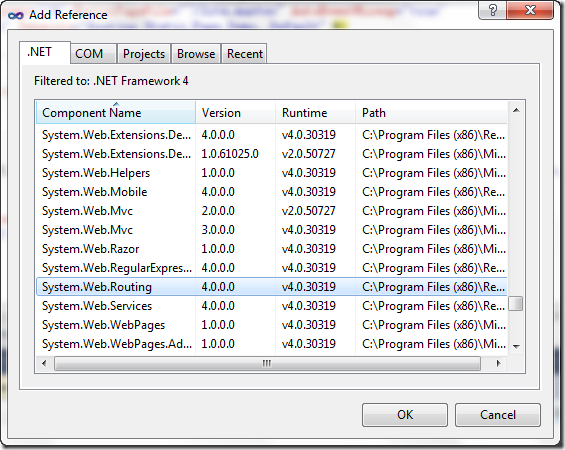
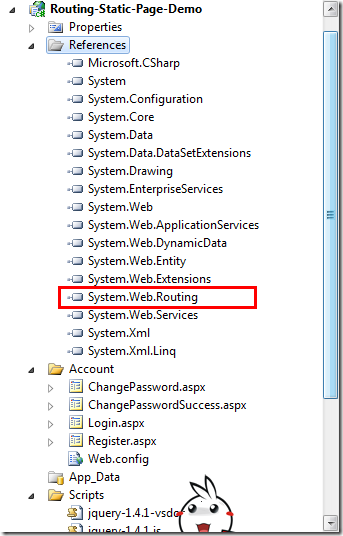
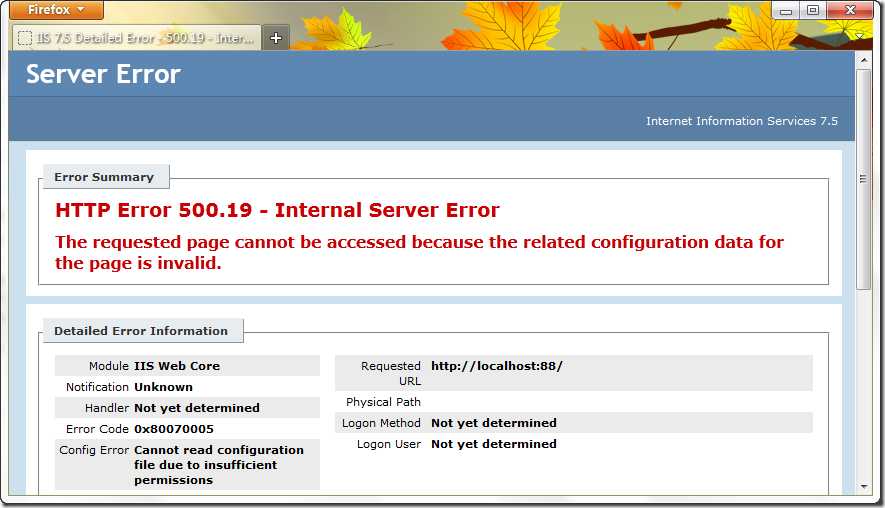
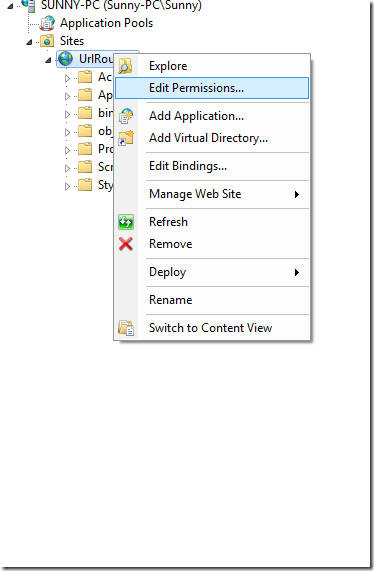
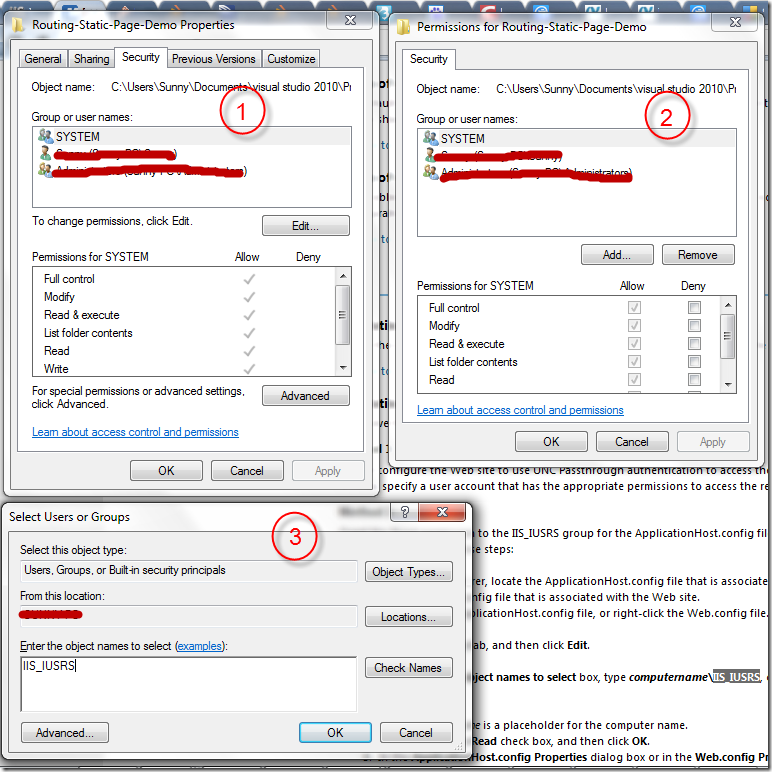
![SNAGHTML2f152df[4] SNAGHTML2f152df[4]](http://images.cnblogs.com/cnblogs_com/keepfool/201203/201203311247388121.png)
